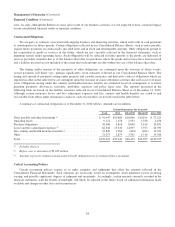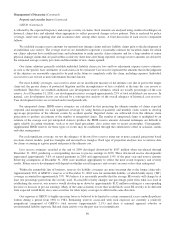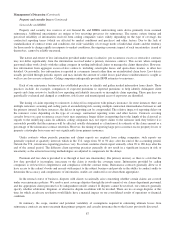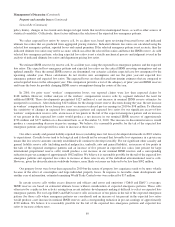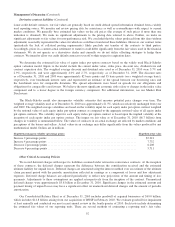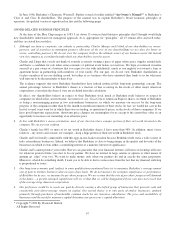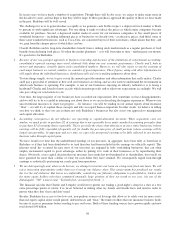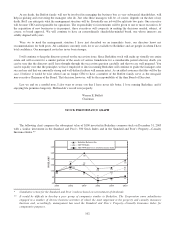Berkshire Hathaway 2010 Annual Report Download - page 94
Download and view the complete annual report
Please find page 94 of the 2010 Berkshire Hathaway annual report below. You can navigate through the pages in the report by either clicking on the pages listed below, or by using the keyword search tool below to find specific information within the annual report.
Management’s Discussion (Continued)
Derivative contract liabilities (Continued)
issuer credit default contracts, our fair values are generally based on credit default spread information obtained from a widely
used reporting source. We monitor and review pricing data for consistency as well as reasonableness with respect to current
market conditions. We generally base estimated fair values on the ask prices (the average of such prices if more than one
indication is obtained). We make no significant adjustments to the pricing data referred to above. Further, we make no
significant adjustments to fair values for non-performance risk. We concluded that the values produced from this data (without
adjustment) reasonably represented the values for which we could have transferred these liabilities. However, our contract terms
(particularly the lack of collateral posting requirements) likely preclude any transfer of the contracts to third parties.
Accordingly, prices in a current actual settlement or transfer could differ significantly from the fair values used in the financial
statements. We do not operate as a derivatives dealer and currently we do not utilize offsetting strategies to hedge these
contracts. We intend to allow our credit default contracts to run off to their respective expiration dates.
We determine the estimated fair value of equity index put option contracts based on the widely used Black-Scholes
option valuation model. Inputs to the model include the current index value, strike price, discount rate, dividend rate and
contract expiration date. The weighted average discount and dividend rates used as of December 31, 2010 were 3.7% and
2.9%, respectively, and were approximately 4.0% and 2.7%, respectively, as of December 31, 2009. The discount rates
as of December 31, 2010 and 2009 were approximately 82 basis points and 55 basis points (on a weighted average basis),
respectively, over benchmark interest rates and represented an estimate of the spread between our borrowing rates and
the benchmark rates for comparable durations. The spread adjustments were based on spreads for our obligations and
obligations for comparably rated issuers. We believe the most significant economic risks relate to changes in the index value
component and to a lesser degree to the foreign currency component. For additional information, see our Market Risk
Disclosures.
The Black-Scholes model also incorporates volatility estimates that measure potential price changes over time. The
weighted average volatility used as of December 31, 2010 was approximately 21.5%, which was relatively unchanged from year
end 2009. The weighted average volatilities are based on the volatility input for each equity index put option contract weighted
by the notional value of each equity index put option contract as compared to the aggregate notional value of all equity index
put option contracts. The volatility input for each equity index put option contract is based upon the implied volatility at the
inception of each equity index put option contract. The impact on fair value as of December 31, 2010 ($6.7 billion) from
changes in volatility is summarized below. The values of contracts in an actual exchange are affected by market conditions and
perceptions of the buyers and sellers. Actual values in an exchange may differ significantly from the values produced by any
mathematical model. Dollars are in millions.
Hypothetical change in volatility (percentage points) Hypothetical fair value
Increase 2 percentage points .............................................................. $7,221
Increase 4 percentage points .............................................................. 7,732
Decrease 2 percentage points .............................................................. 6,208
Decrease 4 percentage points .............................................................. 5,711
Other Critical Accounting Policies
We record deferred charges with respect to liabilities assumed under retroactive reinsurance contracts. At the inception
of these contracts, the deferred charges represent the difference between the consideration received and the estimated
ultimate liability for unpaid losses. Deferred charges are amortized using the interest method over an estimate of the ultimate
claim payment period with the periodic amortization reflected in earnings as a component of losses and loss adjustment
expenses. Deferred charge balances are adjusted periodically to reflect new projections of the amount and timing of loss
payments. Adjustments to these assumptions are applied retrospectively from the inception of the contract. Unamortized
deferred charges were approximately $3.8 billion at December 31, 2010. Significant changes in the estimated amount and
payment timing of unpaid losses may have a significant effect on unamortized deferred charges and the amount of periodic
amortization.
Our Consolidated Balance Sheet as of December 31, 2010 includes goodwill of acquired businesses of $49.0 billion,
which includes $14.8 billion arising from our acquisition of BNSF in February 2010. We evaluate goodwill for impairment
at least annually and conducted our most recent annual review in the fourth quarter of 2010. Such tests include determining
the estimated fair values of our reporting units. There are several methods of estimating a reporting unit’s fair value,
92




